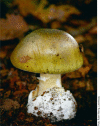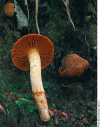Mushroom Poisoning
- PMID: 33559585
- PMCID: PMC7868946
- DOI: 10.3238/arztebl.2020.0701
Mushroom Poisoning
Abstract
Background: Poisonous mushrooms are eaten by mushroom hunters out of ignorance, after misidentification as edible mushrooms, or as a psychoactive drug. Mushroom poisoning commonly leads to consultation with a poison information center and to hospitalization.
Methods: This review is based on pertinent publications about the syndromes, toxins, and diagnostic modalities that are presented here, which were retrieved by a selective search in PubMed. It is additionally based on the authors' longstanding experience in the diagnosis and treatment of mushroom intoxication, expert consultation in suspected cases, macroscopic identification of wild mushrooms, and analytic techniques.
Results: A distinction is usually drawn between mushroom poisoning with a short latency of less than six hours, presenting with a gastrointestinal syndrome whose course is usually relatively harmless, and cases with a longer latency of six to 24 hours or more, whose course can be life-threatening (e.g., phalloides, gyromitra, orellanus, and rhabdomyolysis syndrome). The DRG diagnosis data for Germany over the period 2000-2018 include a total of 4412 hospitalizations and 22 deaths due to the toxic effects of mushroom consumption. 90% of the fatalities were due to the death cap mushroom (amatoxins). Gastrointestinal syndromes due to mushroom consumption can be caused not only by poisonous mushrooms, but also by the eating of microbially spoiled, raw, or inadequately cooked mushrooms, or by excessively copious or frequent mushroom consumption.
Conclusion: There are few analytic techniques available other than the qualitative demonstration of amatoxins. Thus, the diagnosis is generally made on the basis of the clinical manifestations and their latency, along with meticulous history-taking, assisted by a mushroom expert, about the type(s) of mushroom that were consumed and the manner of their preparation.
Figures
Comment in
-
Additional Information Necessary.Dtsch Arztebl Int. 2021 Mar 19;118(11):197. doi: 10.3238/arztebl.m2021.0112. Dtsch Arztebl Int. 2021. PMID: 34024315 Free PMC article. No abstract available.
-
Ergot Alkaloids are Also Mushroom Poisons.Dtsch Arztebl Int. 2021 Mar 19;118(11):197. doi: 10.3238/arztebl.m2021.0113. Dtsch Arztebl Int. 2021. PMID: 34024316 Free PMC article. No abstract available.
References
-
- Jahresberichte des Giftnotrufs München. www.toxinfo.med.tum.de/inhalt/jahresberichte (last accessed on 6 July 2020)
-
- Jahresberichte des Giftinformationszentrums Nord Göttingen. www.giz-nord.de/cms/index.php/jahresberichte.html (last accessed on 6 July 2020)
-
- Informationssystem der Gesundheitsberichterstattung des Bundes. www.gbe-bund.de (last accessed on 24 August 2020)
-
- Zilker T. Vergiftungen durch Pilze Klinische Toxikologie für die Notfall- und Intensivmedizin. Bremen: UNI-MED. 2008:247–270.
-
- Liste der Giftnotrufzentralen. www.bvl.bund.de/DE/Arbeitsbereiche/01_Lebensmittel/03_Verbraucher/09_Inf... (last accessed on 20 July 2020)
Publication types
MeSH terms
Supplementary concepts
LinkOut - more resources
Full Text Sources
Miscellaneous




